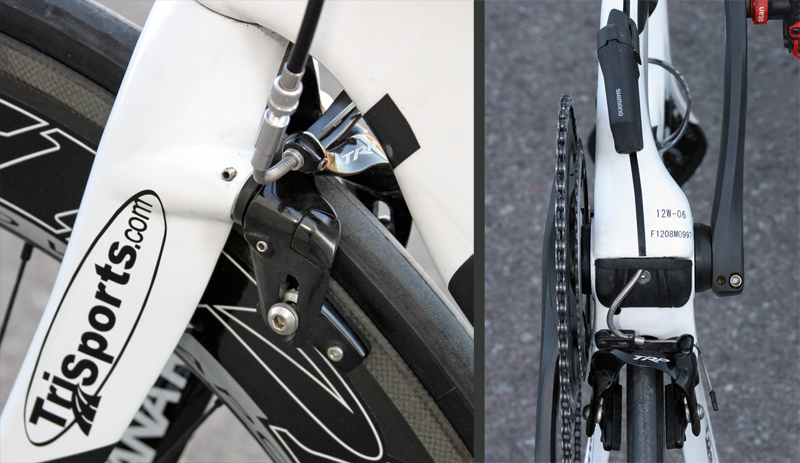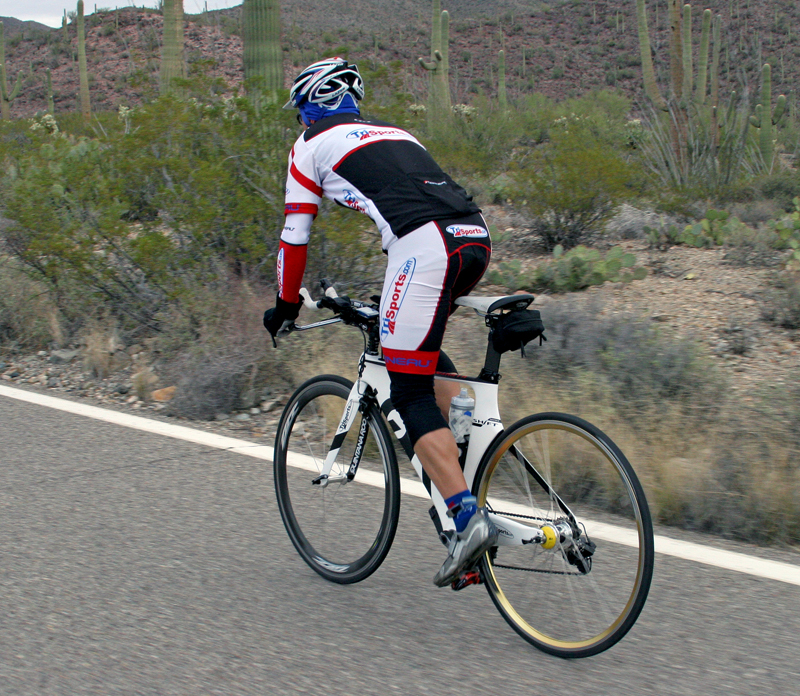This blog entry was taken from TOM DEMERLY OF TRISPORTS on his review of the new QR Illicito. Enjoy.
The logic is simple: If you want to make a bike perform differently you have to design it differently.
The Quintana Roo Illicito is different. The frame has no left seat stay. While the missing seat stay and massive left chain stay are the most visually striking features the SHIFT technology, improved carbon fiber lay-up, redesigned rear brake and BB30 bottom bracket also exert a strong influence on the bike's performance.
The lesson of history is that if you want extraordinary performance you must adopt extraordinary design.
The Illicito has not gotten much media attention mostly due to different industry emphasis and greater effort on product than marketing by Quintana Roo. QR has focused on the steak and not the sizzle. The logic of tossing the UCI rule book and designing a bike specifically for best aerodynamics makes sense- to triathletes. Lotus, Zipp, Softride, Trek, Kestrel and Hotta have all done it. The Quintana Roo Illicito, as the name suggests, is illegal for UCI sanctioned races like the Tour de France. For triathletes: who cares? It's designed to be faster, rules be damned. For QR designing a bike specifically for the triathlete is where they started in 1987. It excludes them from events sanctioned by USA Cycling and professional bicycle racing time trials governed by the UCI. In both politics and technology Quintana Roo walks the walk with the Illicito. They are truly 'True to the Tri' with the Illicito design. And of course, for triathlons the Illicito is entirely legal.
The Illicito is a natural evolution from the company that invented the original triathlon bike back in 1987.
Illicito was developed in the wind tunnel as are most aero bikes from Trek, Specialized and Cervelo. A major difference is that Quintana Roo invented this category: The aerodynamic triathlon bike. And, of course, Quintana Roo makes the claim that the Illicito has the lowest drag numbers where drag numbers matter most. I'm unapologetically cynical about wind tunnel drag numbers. Every manufacturer produces a 'white paper' that supports their sales agenda. On a practical level I will suggest these white papers are best used on a roll next to the loo since they are all purporting the same thing; 'Our bike is best!' They effectively cancel each other. But in the case of the Illicito something prevails: Logic. If the bike has missing frame sections, it ought to be faster simply by virtue of the fact that something is gone. If that is 'Exhibit A' then 'Exhibit B' is the UCI sanction of the Illicito.
The most conspicuous feature of the Illicito is the asymetrical rear end, but other aerodynamic designcues are less obvious such as QR's "SHIFT" orientation of the down tube.
And then there is the emerging anecdotal evidence. TriSports.com founder Seton Claggett can ride any bike, including brands TriSports.com currently doesn't sell. At Ford Ironman Arizona he rode Quintana Roo's Illicito. He had his fastest bike split ever, his fastest Ironman ever. A few weeks before that on his first race on the Illicito he had the fastest amateur bike split at a local event. While any one variable like a new bike can't be attributed with that success, it does track with the trend that Claggett made good equipment choices, trained effectively and executed a good race plan. The convergence was an age category win at Ford Ironman Arizona and a Kona spot.
We discovered the rear end on the Quintana Roo Illicito frameset was extremely stiff in out of the saddle climbs, largely due to the massive left chain stay and high end carbon fiber lay-up.
Because Tennessee based Quintana Roo doesn't have pockets as deep as Specialized and Trek, fortified by mountain bike and hybrid sales, we won't see Craig Alexander or Lance Armstrong on an Illicito. We will see an increasing number of age groupers on the bike from a live swipe of their own credit card- a more relevant endorsement than paid sponsorships.
The logic of the Illicito seems supportable: If you make a design that is tangibly different it will perform tangibly different. There is also an accumulating repository of solid results from people already on the bike. Those two factors merit attention.

If it is made differently, it will perform differently. The asymetrical orientation of the rear
triangle and the massive left chainstay are apparent in these photos.
The Quintana Roo Illicito is currently sold as a frame only. Quintana Roo said there are no immediate plans for a complete bike version. The good thing is you get to pick your own components; the bad thing is this is generally more expensive than buying a complete bike. At this level most customers want a degree of flexibility with components anyway so offering the Illicito as a frameset makes sense for dealers and consumers.
From the front of the frame to the back:
For all its conspicuous features the Illicito is mostly a bike of subtle technology. It starts with the fork. Quintana Roo developed the first aerodynamic fork with the Carbonaero in the late 1980's. Their fork innovation continues with the Illicito fork. The dropout protrude forward of the fork blades adding stability to the front end, a great feature for a bike designed to be ridden in the aero position. Viewed from the front the fork blades arch away from the front wheel dramatically. This aerodynamic feature allows the boundary layer of air to pass between the rotating front wheel and fork blades at lower pressure with less drag and turbulence. The brake is mounted behind the fork, another aerodynamic que. The new brakes have very good stopping power and are a conspicuous improvement over prior efforts.

The fork on the Illicito provides stable handling in the aero position and reduces the pressure of air
between the front wheel and the fork blades by maintaining a large gap from rotating spokes (right).
The head tube of the frame features a conical shape we've also seen on some Cervelo efforts like the P3. The downtube is a deep airfoil shape that harkens to Specialized's new Shiv. Top tube is a flattened shape parallel to the ground. There are two standard bottle cage mounts on the frame, one seat tube, one down tube. I appreciate this feature, rare on an aero frame bike.

Claggett's Ironman AG winning Illicito was controlled from a Shimano Dura-Ace Di2 control set mounted on a Profile "J" bend extension aerobar. Note the elegant cable inlets and Di2 integration on the Illicito frameset.
The cable inlets on Seton Claggett's Illicito were very nicely done Shimano Di2 specific and made for a clean, well conceived presentation. They also do a nice job of sealing out moisture from spilled sports drink and rain. In the case of Claggett's IM AG winning bike the Di2 battery is slung under the down tube. I'd like to see more aero integration of Di2 batteries on all aero bikes. A rumored 'Race Day' battery that is smaller may help resolve this in the next few months. For now Di2 battery mounting on every bike seems like an afterthought. Bike industry: The new coffee flavor is Di2, wake up and smell it!
Moving back on the frame you see the influence of Quintana Roo's 'SHIFT' design doctrine. The down tube angles off to the rider's right toward the crank. SHIFT technology is the first attempt at not only reducing bicycle frame drag, but also mitigating drag caused by the drivetrain. The downtube on a SHIFT technology bike sits 18mm closer to the drive side. It is claimed to 'shift' the boundary layer of air away from the drivetrain to the cleaner, non-drive side of the bike. SHIFT also seems to improve bottom bracket stiffness, a boon when climbing and accelerating. Several other manufacturers have trended toward an asymmetrical bottom bracket with SHIFT leading this trend. While the unique rear end design of the Illicito is the most visually striking the SHIFT technology may be the more effective aerodynamic design feature.

QR's greatly improved aero brakes from TRP. The right photo shows the asymmetrical orientation of
the down tube, improved rear brake and clean cable routing as well as the Di2 battery mount.
Rear bake on the Illicito is a massive improvement over previous under-bottom bracket brakes. The new TRP (Tektro Racing Products) 'U' brake has more powerful return springs, is easier to adjust and holds its center better than previous rear brakes which were, admittedly, quite poor. Another benefit with this brake is the capability to work with the wider aero wheels trending now like Zipp Firecrest, bulge disks and HED's new wider rims. The brake has more 'throw' and leverage to facilitate a more open position and better leverage. This is a great improvement.
Chainstays on the Illicito are wildly asymmetrical giving the bike a lot of visual punch. The thinking is the massive left seat stay provides structural integrity given up by removing the left side seat stay. When asked if a future bike could be built with this design completely replacing both seat stays Quintana Roo's spokesperson went awkwardly silent.

The eye catching rear end of the Illicito includes practical details like clearance for new wide aero
wheels, replaceable, adjustable dropouts and derailleur hanger.
The rear dropouts on the Illicito are all alloy and very robust. They empty to the rear of the bike and are horizontal. At the top of the seat mast there is an alloy binder clamp that uses two bolts, another practical design feature.
One thing that struck me working with the new Illicito is that it is a superbike you can travel with. Most other aero bikes with substantial component integration might not work well going into a flight case and, if something goes wrong when you are at an 'away' race there may not be mechanics and parts on-sight to service the issue. With the exception of the brake calipers, the QR Illicito frame uses fairly standard fittings and fasteners.
Quintana Roo stayed true to their lineage with the fit and geometry of the Illicito since the bike can be ridden at an 80+ degree open seat tube angle. The head tube is a stable and comfortable 72 degrees across every size. Head tube height on the two smaller sizes, 'Small' and 'Medium' are a low 90 millimeters, tracking with Cervelo's P4 and P3 and Felt's 'B' and 'DA' bikes. There are four sizes in the Illicito called 'Small', 'Medium', 'Medium Large' and 'Large'. I am 5'9' and have a long torso so I would be on the 'Medium Large' with the 54cm top tube and the saddle in a forward orientation to open the angle between my torso and femur at the top of the pedal stroke. Seton Claggett, who prefers a more compact position and a slacker effective seat angle, rode the 'Medium' for his Ford Ironman Arizona Age Group victory.

QR stayed true to the tri with their steep angle geometry for a comfortable, open torso to let
position in the aerobars. Seat tube angle is adjustable through a wide range.
There have been a few bikes important enough to influence triathlon specific bike design- most have been from QR over the past few decades. The Quintana Roo Superform was the first to make a real impact on athlete performance and the market. The Illicito may be another. The Illicito puts Quintana Roo firmly back in the top ranks- if not at the very top- of triathlon bike innovation and performance.







